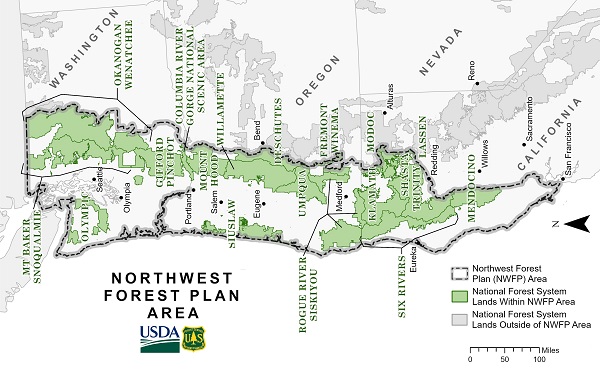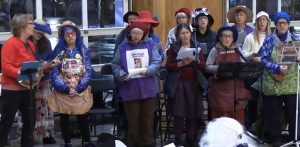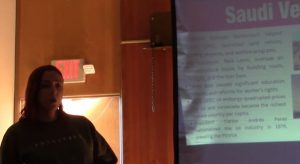Northwest Forest Plan advisors recommend managed fire, tribal co-stewardship
7 min read
A key advisory committee has issued its recommendations for the Northwest Forest Plan. In its final session, during which the committee would complete its recommendations, top officials were also present to hear public comment. In Olympia on June 25:
[00:00:14] Meryl Harrell (USDA): Really good to see you, Meryl Harrell, deputy undersecretary for Natural Resources and Environment at USDA.
[00:00:19] Jacque Buchanan (U.S. Forest Service): Good morning, Jacque Buchanan, regional forester for the Pacific Northwest Region of the U.S. Forest Service and DFO (designated federal officer) for the Northwest Forest Plan Amendment.
[00:00:30] John Q: Among the public comments, the federal officials and their advisory committee heard these three. From Weaverville:
[00:00:37] James Aven (Weaverville, California): My name is James Aven. I am from Weaverville, which is in the Trinity National Forest. So I’m speaking in terms of that I know. I don’t know everybody else’s forest. But we have experienced horrible wildfires there, burned tens of thousands of acres and none of it has been reforested.
[00:01:03] And you all presumably got my written comments, so I ask you to refer to them. And I do want to make clear that while I thought it was inexcusable for people to simply leave the forest after the fires are put out and forget about them, I do not blame anybody or any organization or any of the agencies. It is a social construct and we simply don’t think about these things, I guess.
[00:01:40] So. My concern is that we engage in a wholesale rejuvenation of the forest. And I made in my written comments some suggestions for local opportunities to do that as a sort of way to get started.
[00:02:04] But I think a good example, is what they did in the Tillamook State Forest, where there were some 360,000 acres were burned over a period of 18 years, I think it was, and they have reforested it. It took them 20 years. They planted somewhere over 72 million seedlings, they spread a billion seeds, and thousands of people were involved both as employees and as volunteers to reforest that area. And now it is a beautiful sea of green lush trees.
[00:02:46] I recognize that the Trinity forest, the national forest is not the same. We have a different environmental regime there, but we need to have it rejuvenated. It needs to be reforested. It needs to be able to provide all of the services that we need out of a forest.
[00:03:06] And I do not think that we can allow as a nation, this is a national interest, I think, we cannot allow all of that land to remain fallow and for all the communities to linger in neglect and poverty. I think it’s important that it all be integrated into the national productivity. And I think my time is up. Thank you.
[00:03:38] Matt Comisky (American Forest Resource Council): For the record, my name is Matt Comisky. I am the Washington manager for the American Forest Resource Council. I’m also a member of several forest collaboratives around the state of Washington.
[00:03:48] Today I’m here to provide comments to you that are both personal and professional. The federal government has failed. In 1994, I was blissfully working as a forest engineer in the private forest sector here in Washington state.
[00:04:03] But since that time, I’ve watched rural communities in Washington crumble. East Lewis County where I live, we’ve watched school districts lose students after students after students and that leads to poor educational outcomes, as you lose students.
[00:04:21] A lot of that is because the Forest Service left. I’ve watched and lived the results of the Northwest Forest Plan. And after 30 years, we had a chance to do better. And my comments are really more focused at the Forest Service and the federal government than those of you who are volunteering your time to do this good work. Instead, we appear to have set a low bar by not revising the Northwest Forest Plan.
[00:04:46] Forests are dynamic. They change. They have been managed by humans for centuries. We’re headed towards by not revising, not changing lines on the ground, we’re headed towards a death sentence for the Olympic National Forest and those who rely on it.
[00:05:02] It will go dark in about 30 to 40 years. Maybe about the time we’re amending this Northwest Forest Plan Amendment. In Washington State, of all forest landowners, the Forest Service is in last place on dealing with roads and water issues. We have miles and miles of culverts that need to be addressed. I’ve spent most of my private career addressing road maintenance and fish passage issues to enhance fish recovery on private and state forest lands in this state.
[00:05:33] To the issue of lack of salvage, as a former wildland firefighter, I’ve seen the results of reburns. We need to get out and address fire salvage in the appropriate places. That does not mean everywhere, but that does mean the appropriate places. And if we are truly, truly worried about climate change and the good things that can come from reforestation, we need to get out there on the ground and be reforesting the tens of thousands of acres we are turning black as a society in this country in the Pacific Northwest every year.
[00:06:08] It is something we must do. And the only way we can do that safely is to make sure that we are salvaging the proper locations and that we are making sure that we are investing in the local communities to have the infrastructure to do that type of work.
[00:06:24] We can and must do better. And I’d just like to end: ‘The forester plants trees for a generation they will likely never see.’
[00:06:38] Timothy Ingalsbee (FUSEE): Hello, my name is Timothy Ingalsbee. I’m executive director of Firefighters United for Safety, Ethics, and Ecology. I’ve been with you all four previous FAC meetings. I’m tempted to say I’m a survivor, but so are you. I’ve said it before and I must say it again, how much I appreciate all of you for your personal sacrifices and dedicated public service. I hope the secretary personally thanks each and every one of you for your great contributions.
[00:07:08] The final set of FAC recommendations really showcases the progress of your work. I hope the Forest Service is able to simply copy and paste all the heartfelt and eloquent recommendations in the ‘Tribal Inclusion’ section into their draft EIS.
[00:07:25] This is really the most profoundly new and needed information and change in the Northwest Forest Plan Amendment. I know that this process of tribal engagement has been rushed and frustrating and insufficient, but I want to acknowledge the sincerity of the Forest Service employees who have been involved in this effort. And I believe this is probably the first, few, faltering steps in what may be a long multi-generational journey on a path towards reconciliation, respect, and healing both for people and the land. So I really support that.
[00:08:06] When the Forest Service first announced the Northwest Forest Plan Amendment, and this was actually a few years ago, I suspected that the agency was going to use its wildfire crisis strategy as a driver for ramping up logging again. And I’m not alone in this suspicion. Offering the false solution that commodity timber extraction and aggressive fire exclusion would prevent catastrophic wildfires.
[00:08:34] I think that there’s still very powerful outside political and economic interests who are banking on the public fearing big fires more than they hate big stones, and are hoping that the Forest Service can, you know, offer the false promise, the false illusion, ‘We’ll get the cut out and put the fire out.’
[00:08:56] But if that was the original intention, the hard work of the committee, I think, has altered the course of that crude objective, So I really hope that the Forest Service does take all of your recommendations to heart and really integrates, applies, and implements them.
[00:09:14] And so that, I want to, I can’t even read it, I want to implore you, you may at the end of three days feel exhausted, you’ve done your duty, now you can go home: Stick with it through the EIS process. Your voices have great sway with decision-makers, the public and the press.
[00:09:33] And so the last few seconds I must say, let’s let the Northwest Forest Plan Amendment end the obsolete paradigm of reactive wildfire suppression, replace it with a new paradigm of proactive ecological fire management. I hope all the recommendations regarding beneficial fire use make it through the consensus process. It will be a visionary shift in the whole direction of forest management. So thank you so much for your time and good luck to you all.
[00:10:06] John Q: Congratulations to Timothy Ingalsbee of FUSEE: The first of eight recommendations from the Federal Advisory Committee is titled, ‘Tribal Inclusion.’ The third is ‘Fire Resilience,’ and it recommends: ‘Expand the strategic use of beneficial fire, in areas likely to experience fire, to reduce impacts of wildfire, revitalize Indigenous cultures, regenerate native plant species, rejuvenate wildlife habitats and biomass, support wildlife, etc.’
In the July issue of Firebrand, Timothy notes that the Draft Environmental Impact Statement team agreed to include language on ‘managed wildfire’ in the DEIS. That has been a long-time FUSEE request. Read the committee’s 89-page document in its entirety, and check the FUSEE site for the latest information.






